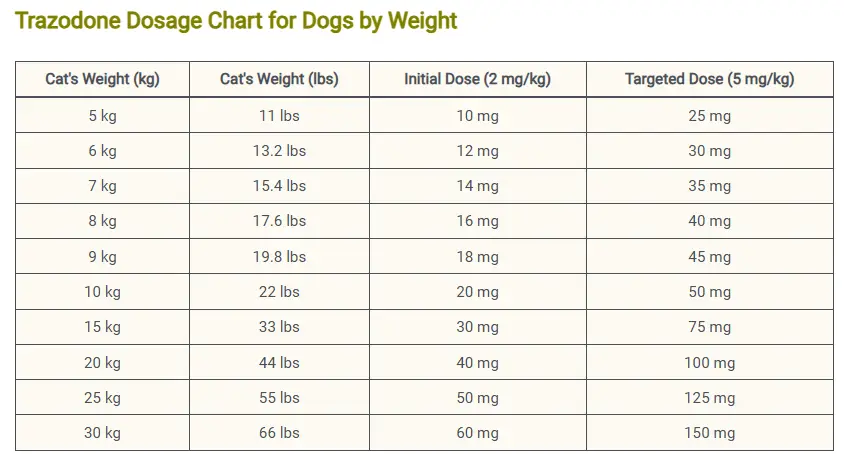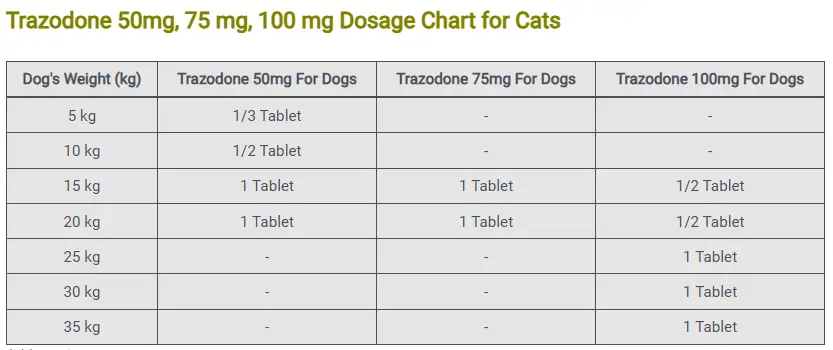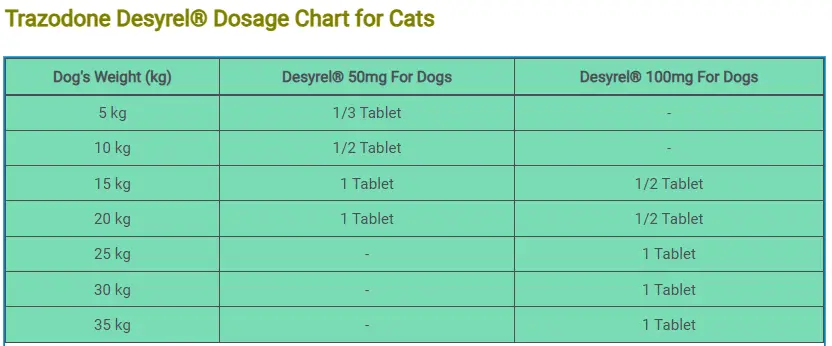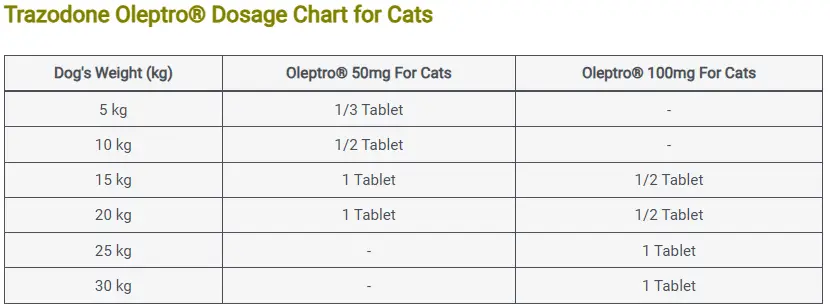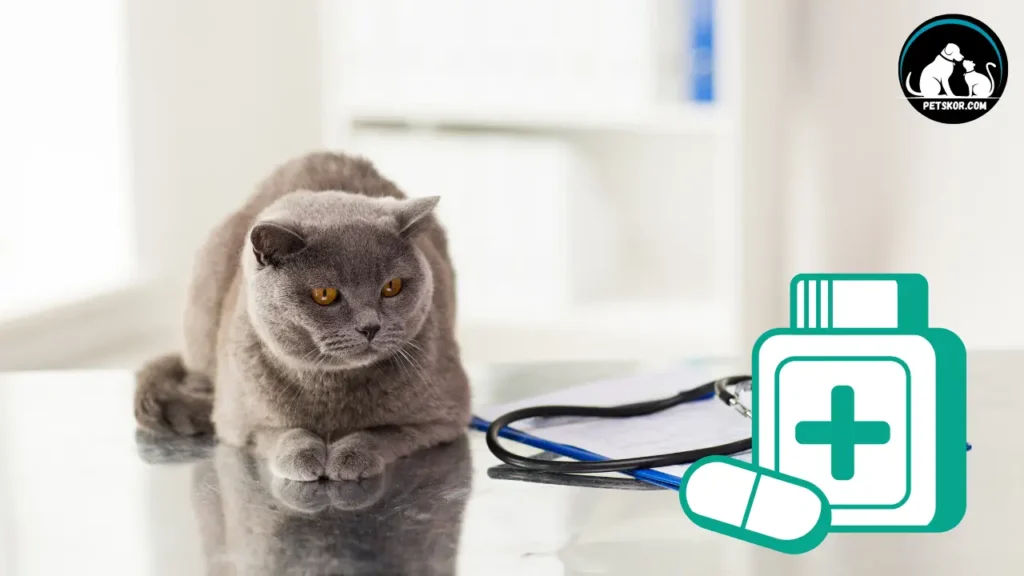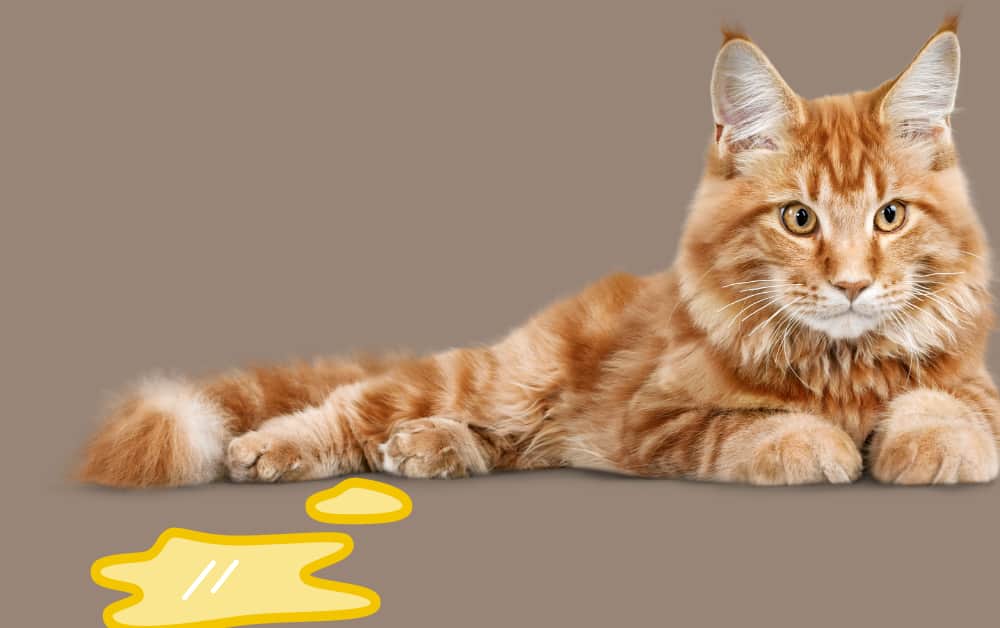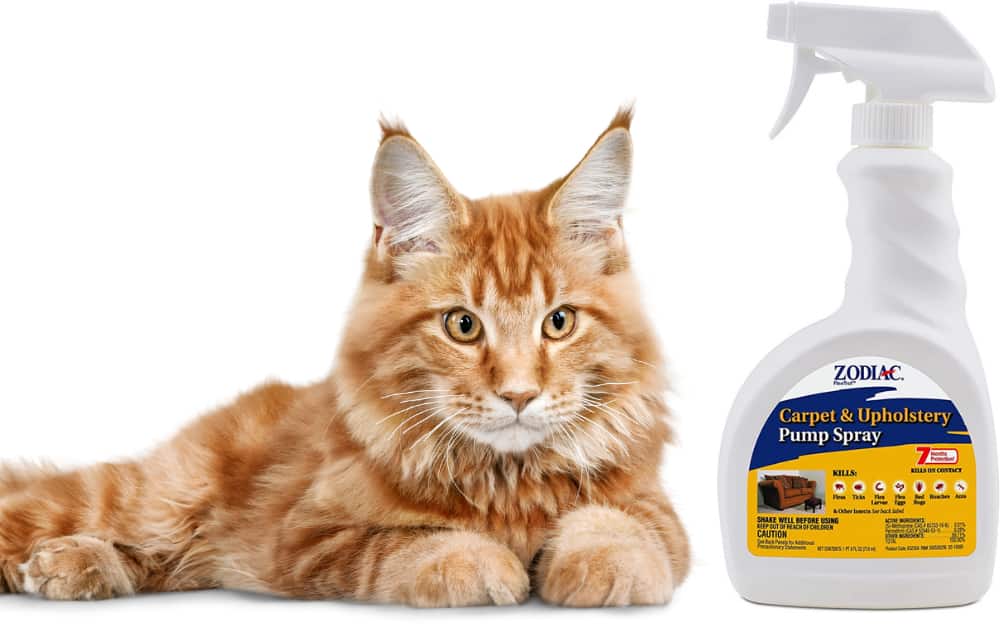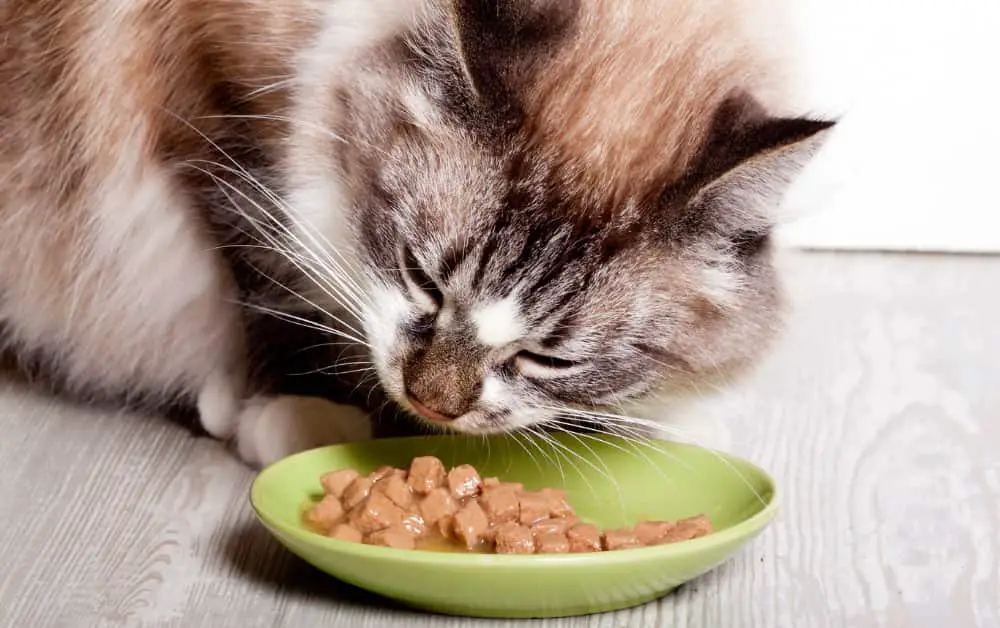When it comes to the mental well-being of our feline friends, it’s important to recognize that, just like humans, cats can experience anxiety and stress. Understanding and addressing these issues is crucial for their overall health.
One medication that has been gaining attention for its effectiveness in treating anxiety and other behavioral issues in cats is Trazodone.
Trazodone For Cats Overview
| Common names | Trazodone (Desyrel, Oleptro) |
| FDA Approved | No |
| Uses | Anxiety and stress relief, Behavior modification, Sedation |
| Side Effects | Sedation, Lethargy, Vomiting, Diarrhea |
| Dosage | 2.5 – 6 mg per pound (5 – 12 mg/kg) once to three times daily |
| Available Forms | Tablets (50 mg, 100 mg), liquid, or transdermal lotion |
| Administration | Oral administration with or without food |
| Safety | Should not be used in cats with hypersensitivity to trazodone or similar drugs |
| Storage | 20 and 25 degrees C (68-77 degrees F) |
| Average cost | Approximately $4-$15 (30-day supply) |
What is Trazodone for Cats?
Trazodone for cats is a serotonin antagonist and reuptake inhibitor (SARI) widely used for treating anxiety and stress-related issues in felines, such as separation anxiety, travel anxiety, fireworks anxiety, aggression, and post-surgical recovery.
Trazodone’s ability to modulate serotonin levels makes it effective in altering mood and behavior, which is why it is now being considered for use in veterinary medicine.
Is Trazodone Safe for Cats?
Yes, Trazodone is safe for dogs when administered in the correct dosage prescribed by a veterinarian. However, certain felines cannot take Trazodone and it may be considered unsafe for them.
Overdosing on the medication can be toxic, so make sure to follow your vet’s instructions to avoid any complications.
Trazodone Dosage for Cats
The ideal dosage of trazodone for cats is 5-6 mg/kg, with an average of 50 mg per cat, for treating separation anxiety, noise phobia, and veterinary visits. To determine the correct dosage, start with an initial dose of 2-3 mg/kg and then increase to the maintenance dose of 5-6 mg/kg as needed. Never exceed a dose of 10 mg/kg.
- Ideal dose: 5-6 mg/kg (2.3-2.7 mg/lb)
- Initial Dose: 2-3 mg/kg (0.9-1.4 mg/lb)
- Maintenace Dose: 5-6 mg/kg (2.3-2.7 mg/lb)
- Maximum Dose: 10 mg/kg (4.5 mg/lb)
Dosage Instructions
Administration:
- Method: Administer by mouth.
- Timing: Give on an empty stomach. If vomiting occurs, the next dose can be given with food.
- Effect: The medication takes effect within 1 to 2 hours and lasts about 10-12 hours.
- Pre-Surgical Sedation:
- Administer the dose the night before the surgery.
- Administer again at least 2 hours before the appointment on the day of surgery.
Tablet Administration Tips:
- Place the tablet well back on the cat’s tongue.
- Hold the cat’s mouth shut until they swallow.
- If the cat spits out the tablet, try again with a little wet food or wrapped in a small piece of meat.
Trazodone Dosage Chart for Dogs by Weight
| Cat’s Weight (kg) | Cat’s Weight (lbs) | Initial Dose (2 mg/kg) | Targeted Dose (5 mg/kg) |
|---|---|---|---|
| 5 kg | 11 lbs | 10 mg | 25 mg |
| 6 kg | 13.2 lbs | 12 mg | 30 mg |
| 7 kg | 15.4 lbs | 14 mg | 35 mg |
| 8 kg | 17.6 lbs | 16 mg | 40 mg |
| 9 kg | 19.8 lbs | 18 mg | 45 mg |
| 10 kg | 22 lbs | 20 mg | 50 mg |
| 15 kg | 33 lbs | 30 mg | 75 mg |
| 20 kg | 44 lbs | 40 mg | 100 mg |
| 25 kg | 55 lbs | 50 mg | 125 mg |
| 30 kg | 66 lbs | 60 mg | 150 mg |
The above Trazodone dosage chart for cats by weight is for educational purposes only and should never replace your veterinarian’s advice. Your veterinarian will determine the appropriate Trazodone HCl dosage for your feline based on its individual health condition.
Related Post: Pyrantel Pamoate Dosage for Cats
Trazodone 50mg, 75 mg, 100 mg Dosage Chart for Cats
| Dog’s Weight (kg) | Trazodone 50mg For Dogs | Trazodone 75mg For Dogs | Trazodone 100mg For Dogs |
|---|---|---|---|
| 5 kg | 1/3 Tablet | – | – |
| 10 kg | 1/2 Tablet | – | – |
| 15 kg | 1 Tablet | 1 Tablet | 1/2 Tablet |
| 20 kg | 1 Tablet | 1 Tablet | 1/2 Tablet |
| 25 kg | – | – | 1 Tablet |
| 30 kg | – | – | 1 Tablet |
| 35 kg | – | – | 1 Tablet |
Trazodone Oleptro® Dosage Chart for Cats
| Dog’s Weight (kg) | Oleptro® 50mg For Cats | Oleptro® 100mg For Cats |
|---|---|---|
| 5 kg | 1/3 Tablet | – |
| 10 kg | 1/2 Tablet | – |
| 15 kg | 1 Tablet | 1/2 Tablet |
| 20 kg | 1 Tablet | 1/2 Tablet |
| 25 kg | – | 1 Tablet |
| 30 kg | – | 1 Tablet |
Trazodone Desyrel® Dosage Chart for Cats
| Dog’s Weight (kg) | Desyrel® 50mg For Dogs | Desyrel® 100mg For Dogs |
|---|---|---|
| 5 kg | 1/3 Tablet | – |
| 10 kg | 1/2 Tablet | – |
| 15 kg | 1 Tablet | 1/2 Tablet |
| 20 kg | 1 Tablet | 1/2 Tablet |
| 25 kg | – | 1 Tablet |
| 30 kg | – | 1 Tablet |
| 35 kg | – | 1 Tablet |
What is trazodone used for in cats?
Trazodone is commonly used to address a variety of behavioral issues in cats. These include:
- Separation Anxiety: When a cat becomes distressed when left alone. Learn more about separation anxiety in cats.
- Travel Anxiety: Stress and anxiety associated with car rides or plane trips.
- Fear of Loud Noises: Such as thunderstorms or fireworks anxiety.
- Aggression: Towards other animals or people.
- Post-Surgical Recovery: To keep cats calm and relaxed during recovery.
Related Post: Miralax Dosage For Cats
How Does Trazodone Work in Cats?
In cats Trazodone works by increasing the amount of serotonin in the brain, a neurotransmitter that plays a key role in mood regulation. In felines, it helps to calm anxiety and reduce stress by making more serotonin available in the brain.
This adjustment in brain chemistry can help alleviate symptoms of anxiety, fear, and aggression.
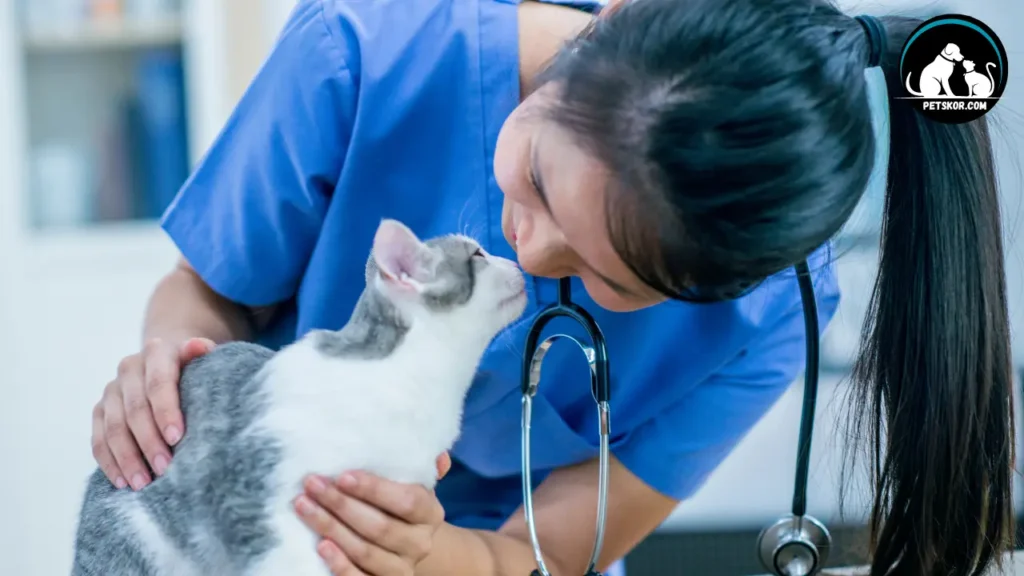
Efficacy of Trazodone in Cats
In a study involving six laboratory cats, the effects of single doses of trazodone (50 mg, 75 mg, and 100 mg) and a placebo were evaluated. The administration of trazodone 100 mg and placebo was randomized.
Researchers compared pre- and post-study laboratory values and conducted physical examinations to identify any potential changes. Sedation levels were measured during each 4-hour period post-treatment using accelerometers and video observations, which were scored by an observer who was blinded to the treatments.
Additionally, behavioral responses were assessed 90 minutes after treatment by the same blinded observer.
Results:
- Adverse Effects and Physical Changes: No adverse effects or changes in physical examinations or laboratory values were observed as a result of trazodone administration.
- Sedation Levels: Accelerometer data indicated significant sedation with trazodone doses:
- 50 mg: 83% reduction in activity
- 75 mg: 46% reduction in activity
- 100 mg: 66% reduction in activity
- In contrast, there was a 14% increase in activity after placebo administration.
- Video Observation Scores: A significant reduction in sedation scores was noted with trazodone 100 mg compared to placebo, with peak sedation occurring approximately 2 hours after administration.
- Behavioral Response: There were no significant differences in behavioral responses during examinations at 90 minutes post-treatment between cats receiving trazodone 100 mg and those given placebo.
Conclusions and Relevance:
- Trazodone was well tolerated by the cats and caused notable sedation at all tested doses.
- Behavioral responses during examinations did not significantly differ with trazodone 100 mg compared to placebo.
- Further research is recommended to explore the use of oral trazodone in cats to reduce anxiety associated with transportation and examinations.
Trazodone Side Effects in Cats
- Vomiting or gagging
- Increased anxiety
- Dilated pupils
- Sedation and lethargy
- Colitis
- Heart arrhythmias
- Increased appetite
- Aggression
- Seizures
- Difficulty breathing
- Severe allergic reactions
Signs of Trazodone Overdose in Felines
- Low blood pressure (hypotension)
- Tremors or seizures
- Difficulty breathing
- Hyperthermia (increased body temperature)
- Hypothermia (decreased body temperature)
- Disorientation
Does Trazodone Interact with any Other Cat Medications?
Yes, trazodone can interact with other medications that felines may be taking. Some potential interactions include:
- Central nervous system depressants (diazepam, clonazepam, zolpidem, phenobarbitol)
- NSAIDs (ibuprofen, indomethacin, celecoxib, naproxen sodium)
- Antihypertensive drugs (Hydrochlorothiazide, metropolol sulfate, indapamide, et al.)
- Salicylate pain medications (acetylsalicylic acid)
- Opioid analgesic (tramadol)
- Azole antifungals (fluconazole, itraconazole, econazole, terconazole, butoconazole, tioconazole)
- Gastrokinetic (cisapride)
- Group V antiarrhythmics (digoxin)
- Fluoroquinolones (ciprafloxacin, delafloxin)
- Macrolide antibiotics (azithromycin, erythromycin)
- Monoamine oxide inhibitors (phenelzine, isocarboxazid, tranylcypromine)
- Dopamine antagonists (metoclopramide)
- 5 HT3 receptor antagonist (ondansetron)
- Phenothiazines (chlorpromazine, thioridazine)
- SSRI antidepressants (paroxetine, sertraline, fluoxetine)
How to Give Your Cat Trazodone.
Administering trazodone to a cat should always be done under the guidance of a veterinarian. Trazodone is a medication commonly prescribed to cats for anxiety, stress, or certain behavioral issues. Here are the general steps you should follow:
1. Consult Your Veterinarian
- Prescription: Ensure trazodone is prescribed by your vet.
- Dosage: Get the correct dosage information based on your cat’s weight, age, and medical condition.
2. Prepare the Medication
- Form: Trazodone can come in tablets or liquid form. Ensure you have the correct form as prescribed.
- Splitting Tablets: If the dosage requires splitting a tablet, use a pill splitter to ensure an accurate dose.
3. Administering the Medication
- Method: Decide on the method to give the medication:
- Directly by Hand: Place the pill or liquid in your cat’s mouth.
- Food: Mix the medication with a small amount of wet food or a treat. Ensure your cat consumes the entire portion.
Direct Administration
- Prepare Your Cat: Hold your cat gently but firmly.
- Open Mouth: Gently open your cat’s mouth by pressing at the hinge of the jaw.
- Insert Medication: Place the pill or liquid dropper at the back of the tongue.
- Close Mouth: Close your cat’s mouth and hold it closed until they swallow. You can encourage swallowing by gently stroking their throat or blowing on their nose.
With Food
- Mix Medication: Crush the pill (if needed) and mix it with a small amount of wet food or a treat.
- Monitor: Ensure your cat eats the entire portion to receive the full dose.
4. Post-Administration
- Reward: Give your cat a treat or affection as a reward to create a positive association.
- Monitor: Observe your cat for any side effects such as sedation, vomiting, or changes in behavior. Contact your vet if you notice any concerning symptoms.
5. Follow-Up
- Consistency: Administer the medication consistently as per the vet’s instructions.
- Communication: Keep your vet informed about your cat’s response to the medication.
Safety Tips
- Storage: Keep trazodone out of reach of children and pets.
- Dosage Accuracy: Never adjust the dosage without consulting your vet.
- Emergency: In case of overdose or adverse reactions, contact your veterinarian immediately.
Alternatives to Trazodone
- Gabapentin: Often used for anxiety and pain relief.
- Fluoxetine: An SSRI (Selective Serotonin Reuptake Inhibitor) used for anxiety, aggression, and obsessive-compulsive disorders.
- Buspirone: An anti-anxiety medication that can help with fear and anxiety.
- Amitriptyline: A tricyclic antidepressant that can be used for anxiety and other behavioral issues.
Natural Supplements:
- L-Theanine: An amino acid found in green tea that can help with anxiety.
- CBD Oil: Cannabidiol can have calming effects and is used for various anxiety-related issues.
- Zylkene: A supplement derived from casein (a milk protein) that can help manage stress.
- Bach Flower Remedies: Natural flower extracts that are used to alleviate stress and anxiety.
FAQs
What should you do if your cat misses a dose of trazodone?
If your cat misses a dose of trazodone, give it as soon as you remember. If it’s almost time for the next dose, skip the missed dose and resume the regular schedule. Do not double up doses to make up for the missed one.
Is there a difference between veterinary trazodone and human trazodone?
The active ingredient in veterinary and human trazodone is the same, but the formulations and dosages may differ. Always use trazodone prescribed specifically for your pet by a veterinarian.
Is trazodone available over the counter?
No, trazodone is not available over the counter. It is a prescription medication that must be prescribed by a healthcare provider or a veterinarian.
What do I do in case of an emergency?
In case of an emergency, contact your veterinarian or an emergency veterinary clinic immediately. If your pet has ingested a toxic amount, seek urgent medical attention.
Why do vets prescribe trazodone?
Vets prescribe trazodone to help manage anxiety, stress, and behavioral issues in pets. It can also be used as a premedication to calm pets before medical procedures or travel.
How long does trazodone last in pets?
Trazodone typically lasts between 8 to 12 hours in pets, but the duration can vary depending on the individual animal’s metabolism and the dosage given.
Can trazodone kill a cat?
While trazodone is generally safe when used as prescribed, an overdose can be dangerous and potentially fatal. Always follow the veterinarian’s dosage instructions carefully.
Can I give my cat trazodone every day?
Yes, trazodone can be given to cats daily if prescribed by a veterinarian. The dosage and frequency should be strictly followed as directed by your vet.
Can Trazodone Cause Weight Gain in Cats?
Weight gain is not a common side effect of Trazodone in cats.
Is Trazodone Effective for All Cats?
Effectiveness can vary; some cats respond better to other treatments.
How to Store Trazodone?
Store in a cool, dry place away from direct sunlight and out of reach of children and pets.
Are There Any Natural Alternatives?
Natural alternatives include pheromone diffusers, calming supplements, and behavioral therapy.
Final Thoughts
Trazodone can be a valuable tool in managing anxiety and behavioral issues in cats. While it comes with potential side effects, with proper veterinary guidance, it can significantly improve a cat’s quality of life. Always consult with a veterinarian before starting or stopping any medication.
References:
A Medication to Help Manage Fear and Anxiety – goodrx.com
Trazodone treats situational anxiety in cats -singlecare.com
Use of oral trazodone for sedation in cats -pubmed.ncbi.nlm.nih.gov
